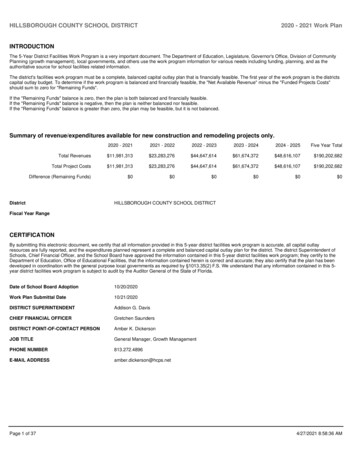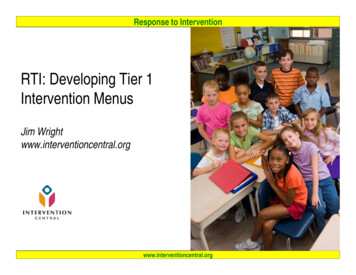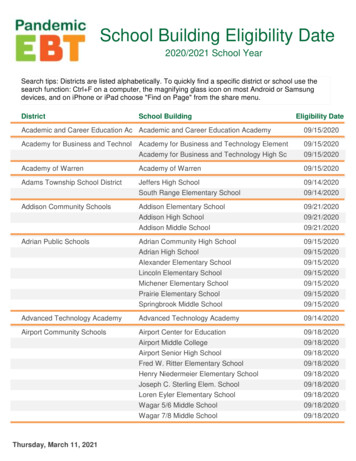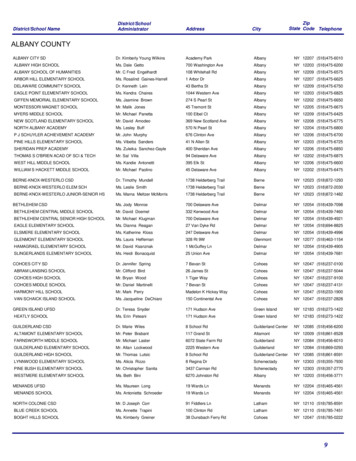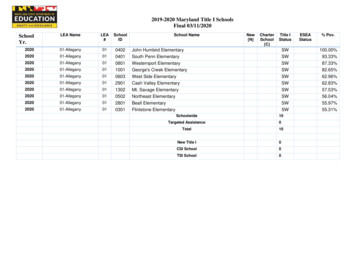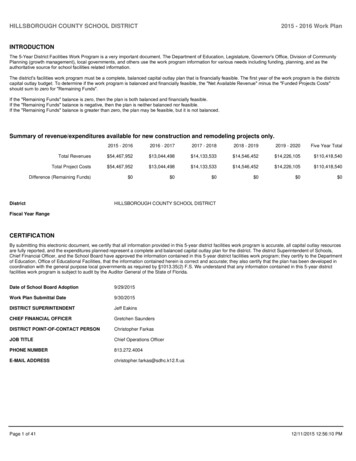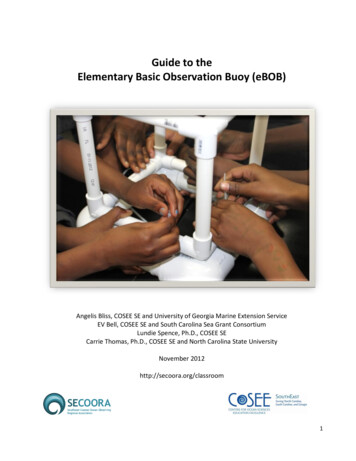
Transcription
Guide to theElementary Basic Observation Buoy (eBOB)Angelis Bliss, COSEE SE and University of Georgia Marine Extension ServiceEV Bell, COSEE SE and South Carolina Sea Grant ConsortiumLundie Spence, Ph.D., COSEE SECarrie Thomas, Ph.D., COSEE SE and North Carolina State UniversityNovember 2012http://secoora.org/classroom1
Table of ContentsAcknowledgementsIntroduction to the eBOB GuideBackground of the eBOB ProjectIncorporating eBOB into the Classroom: Standards and OptionseBOB and StandardsNational Science Education Standards (NSES)Next Generation Science Standards (NGSS)Ocean Literacy Essential PrincipalseBOB Implementation TimelineAll About Buoys: An Introduction to BuoysIntroductory eBOB ActivitieseBOB Sink or Float: Prediction/Observation ActivityPhase 1: BuoyancyPhase 2: FlotationPhase 3: New MaterialsStudent WorksheetCan Clay Float in Water?eBOB Options: eBOB or eBOB in A BageBOB: A Multi Class BuoyDesign & Construction ActivitySuggested MaterialseBOB Payload ChallengeUsing eBOB to Gather Environmental DataAccessories for eBOB: Equipment to Complete the OutfitStudent Data Collection SheeteBOB in a Bag: A 45-Minute BuoyDesign & Construction ActivitySuggested MaterialReferences and ResourcesGlossary2
AcknowledgementsWe wish to acknowledge the initiation of the scaled-down educational observation buoys to DougLevin, Ph.D., Washington College, Chestertown, MD. Other project and editing assistance camefrom Terri Kirby Hathaway, North Carolina Sea Grant & COSEE SE, Megan Treml, SECOORA, LisaAdams, Ph.D., Kennesaw State University, Atlanta, GA, and Jennifer Dorton, NOAA in the Carolinas.We thank Pam Van Dyk, Ph.D., Evaluation Resources, Raleigh, NC, for her evaluation of the piloteBOB work in South Carolina along with the following teachers who worked with us to test andimplement eBOB in various manifestations in their classrooms:Halley Page, Fowler Drive Elementary School (Athens, Georgia)Joanna Coe, St Andrews Academy (Savannah, Georgia)Steven King, Whit Davis Elementary School (Athens, Georgia)Liz Wood, Murray LaSaine Elementary School (Charleston, South Carolina)Janet Beckett, Murray LaSaine Elementary SchoolAllison Rouse, Mitchell Elementary School (Charleston, South Carolina)Lori Holbrook, Mitchell Elementary School (Charleston, South Carolina)David Wingard, Mitchell Elementary School (Charleston, South Carolina)Photos in this guide are credited to Elizabeth (EV) Bell and Angela Bliss unless noted otherwise.This project was funded through SECOORA with NOAA funds (Award NumberNA11NOS0120033) and through COSEE SE with NSF funds (Award Number OCE-1038397).eBOB stability and buoyancy being tested during the eBOB construction phase.3
Introduction to the eBOB GuideWe’re excited that you’ve opened the guide and are ready to meet eBOB, an elementary basicobservation buoy that can help teach science, technology, engineering, and mathematics whileencouraging students to engage creative thinking, problem solving, and teamwork skills.A pilot elementary ocean science program, Our Amazing Coast, developed by COSEE SE withfunding assistance from the Southeast Coastal Ocean Observation Regional Association (SECOORA),focused on one STEM (science, technology, engineering, and math) activity per 3rd, 4th and 5thgrades. The idea of a buoy easily built and manipulated by smaller hands led to the classroomapplication of the elementary Basic Observation Buoy (eBOB). eBOB has been tested inelementary classrooms and STEM demonstration days during the 2011 and 2012 school years.The Guide to the Elementary Basic Observation Buoy (eBOB) will assist with setting the stage fordesigning and constructing an eBOB. The guide starts with background information on buoy typesand functions then moves to suggested introductory activities to launch the project. Along theway, the guide will assist in preparing and buying materials for construction and outfitting eBOBs tocollect data. The Guide to the Elementary Basic Observation Buoy (eBOB) contains backgroundinformation, material lists to assist in constructing eBOBs, supportive lessons, options toincorporate eBOB into your classroom, a glossary to enrich students’ vocabulary, and buoy relatedresources.The Guide to the Elementary Basic Observation Buoy (eBOB) objective is to keep eBOB inexpensive.Teachers and educators can align the eBOB with specific national and state standards in physical,life and earth sciences. If you have a new activity, discover a different way of introducing data toelementary students, or use new equipment, let us know so we can share with others. Email COSEESE Marine Education Specialist, Angela Bliss (acbliss@uga.edu).In the figure above, eBOBs outfitted with student made anemometers andthermometers are tethered and deployed in a Charleston pond.4
Background of the eBOB ProjectConnecting students with authentic scientific research, data gathering and analyzing, andtechnology use are current themes in education. Ocean science engages students with coastal andmarine environments and the technologies used to understand and conserve.The Southeast Coastal Ocean Observation Regional Association (SECOORA) is part of a nationalnetwork designed to monitor and analyze information about coastal waters. Using instrumentedbuoys and land-based radar, scientists are gathering continuous information about physical factorssuch as currents, waves, temperature, and winds; chemical factors such dissolved oxygen, pH, andnutrients; and biological factors such as larval transport of fish and invertebrate (More informationon the SECOORA website: http://secoora.org).The Center of Ocean Sciences Education Excellence Southeast (COSEE SE) in a partnership withSECOORA has piloted a set of activities that engage students with marine technologies that allowthem to work as scientists and assist with the understanding of data about coastal ocean. Thiscollection of activities aligns with national and state standards that support science, technology,engineering, and mathematics (STEM) disciplines.The BOB (Basic Observation Buoy) project started in 2008 as a scaled-down student versioncapable of holding water quality sensors and weather instruments. Pictured below, BOB was isconstructed from 4-inch PVC pipe and fittings. The BOB project came to the southeast regionthrough SECOORA and COSEE SE workshops and targeted middle school students throughundergraduate audiences. The more technical Real-time Advanced Basic Observation Buoy(RABOB) was developed at the University of North Florida and is being incorporated into graduatelevel projects. To allow for smaller hands to manipulate the building materials, Build A Buoy (BAB),was created which provides the opportunity for young children to build a basic buoy. Furtherinformation on BOB, RABOB, and BAB can be found on SECOORA’s webpage(http://secoora.org/classroom).From the conceptual lineage of BOB, RABOB andBAB, eBOB was born to provide elementarystudents with opportunities to build scientificinquiry and problem solving skills whileincorporating STEM disciplines through eBOBconstruction and data collection.We hope that you and your students enjoylearning about buoys, constructing an eBOB withfellow students, and analyzing the datacollected.Photo credit: Doug Levin5
Incorporating eBOBs into the Classroom: Standards and OptionseBOB and StandardseBOB lessons align with many of the National Science Education Standards(http://www.nap.edu/openbook.php?record id 4962) and the emerging Next Generation ScienceStandards (http://www.nextgenscience.org/), including STEM.While state standards vary, teachers can find ways to align eBOB to the Ocean Literacy EssentialPrinciples (http://oceanliteracy.wp2.coexploration.org/) that identify major concepts that studentsand adults should understand about the ocean.Some of the principles and standards are listed below:National Science Education Standards (NSES)K - 4th Grade: Science as Inquiry Physical Science Life Science Earth and Space Science (Weather) Science & Technology Science in Personal and Social Perspectives5th – 8th Grade Science as Inquiry Physical Science Earth and Space Science (Weather and the Ocean) Science & Technology Science in Personal and Social PerspectivesNext Generation Science StandardsThe Next Generation Science Standards (NGSS) are currently under development. NGSS will bebased on research from the National Research Council and based on the Framework for K-12Science Education.Ocean Literacy Essential Principles#3. The ocean is a major influence on weather and climate. (a, b)#5. The ocean supports a great diversity of life and ecosystems. (f)#6. The ocean and humans are inextricably interconnected. (a, e, f)#7. The ocean is largely unexplored. (d)6
eBOB Implementation TimelineJust like NOAA’s real-time observational buoys vary in shape and size based on their function andmooring location, eBOBs differ in shape, size, and function. The COSEE SE eBOB pilot projectconsidered time restrictions and budgetary requirements. Below are general eBOB overviews andsuggestions to help fit eBOB into a science class, school activities, or a science club.A. 45-Minute eBOB in a Bag10 minutes: Introduce buoys15 minutes: Construct eBOB in a Bag20 minutes: ACTIVITY: Payload Challenge and wrap upB. 3-Hour (Day) eBOB15 minutes: Introduce buoys20 minutes: ACTIVITY: Sink or Float: Prediction/Observation Phases 1, 2, & 35 minutes: Introduce materials to be used in constructing eBOB30 minutes: Design, construct, and conduct initial float test buoys20 minutes: Modify and retest flotation30 minutes: ACTIVITY: Payload Challenge20 minutes: Data collection equipment introduction and discussion20 minutes: Construct data collecting equipment (if needed)20 minutes: Deploy buoys, record data, and wrap upC. 6-Hour (Day) eBOB45 minutes: Weather focused Guest Speaker or Research Scientist30 minutes: Introduce buoys30 minutes: ACTIVITY: Sink or Float: Prediction/Observation Phases 1, 2, & 315 minutes: Introduce materials to be used in constructing eBOB60 minutes: Design, construct and conduct initial float test buoys15 minutes: Modify and retest flotation45 minutes: ACTIVITY: Payload Challenge30 minutes: Data collection equipment introduction and discussion30 minutes: Construct data collecting equipment (Optional)30 minutes: Deploy buoys and record data30 minutes: Discuss data that were collected and wrap upStudents have selected PVC pipesections and fittings and are testing thepossibilities of how these pieces can fittogether to make an eBOB.7
All About Buoys: An Introduction to BuoysWhat are buoys? Buoys are floating structures that come in a variety of shapes and sizes and areconstructed from metal and plastics components. Some buoys are moored, or anchored to thebottom; some buoys drift with the currents.What do buoys do?Buoys are used in lakes, rivers and coastal and ocean waters. Buoys have various functions innavigation, data collection, and monitoring.1. Channel markers and channel buoys prevent ships and recreation vessels from running agroundor colliding with other vessels by keeping them out of shallow water. Some markers and buoyshave bells, horns, lights, and other identification marks. Channel buoys are moored to the bottomand assist with navigation much like the traffic signals and signs that guide vehicle traffic on theroads. Channel markers are color coded (red or green) and can be floating or fixed. To helpremember what each color means memorize the following expression: “red right returning.” Thismeans that when returning to the harbor, the red marker should be on your right. Channel markersalso assist boaters in providing information so they know their location. For more information onnavigational buoys visit the United States Coast Guard website(http://www.uscgboating.org).2. Temporary buoys, like dive flags, mark the location of scuba divers. Dive flags indicate to nearbyboaters that scuba divers are beneath the water’s surface and to not approach the dive site.3. Trap buoys mark the location of crab, lobster and other traps or pots for harvesting seafood.These colorful buoys are floating spheres that are tethered to an underwater trap, such as a crabtrap, and are labeled with the owner’s information. These buoys serve dual purposes; to warnboaters of nearby traps and tether ropes so boaters can navigate safely around the gear, to provideinformation on who owns the trap.4. Observational buoys are much larger than theothers mentioned and can be up to 30 ft. tall! Thesebuoys collect data with instruments attached to thestructure. Observational buoys are moored to stay inplace. The National Oceanic and AtmosphericAdministration (NOAA) deploy and maintain buoysalong the US coastlines including the Great Lakes. Agreat example of an observational buoy is the Gray’sReef National Marine Sanctuary buoy that is mooredabout 12 miles off shore from Savannah, Georgia.Pictured to the right, this buoy, like many otherobservational buoys, has sensors relayinginformation about currents, wave height, and windspeed to shore based offices. Data collected fromabout 1,163 observational buoys can be found onNOAA’s National Data Buoy Center’s website(http://www.ndbc.noaa.gov).Photo credit: NOAA NBDC8
Introductory eBOB ActivitiesEducators often prepare their students for constructing their eBOB by introductory activities thatassist with vocabulary building, nature of science, and manipulation skills focusing on makingpredictions and comparing these to their observations.The following activities are found in The Guide for the Elementary Basic Observation Buoy (eBOB)and can be used in whole or adapted as needed.eBOB Sink or Float: Prediction/Observation ActivityPhase 1: BuoyancyPhase 2: FloatationPhase 3: New MaterialsCan Clay Float in Water?Pictured above, students manipulate equal size clay pieces (one rounded in a balland the other flattened like a pancake) so that the clay will sink or float in water.9
eBOB Sink or Float: Prediction/Observation ActivityPhase 1: BuoyancyObjective(s): Predict, test, and observe if objects will sink or float. Compare and contrast the observations.Vocabulary: Float Buoyancy Prediction ObservationSuggested Materials: 1 Tall clear container (ex. Pickle jar) Water to fill container Selection of items to test, such as pingpong ball, golf ball, empty capped bottle,capped bottle full of water Student WorksheetPencilProcedure (Demonstration):1. Distribute a Student Worksheet to each student or group of students.2. Introduce the vocabulary and discuss the importance of experimenting and makingpredictions.3. Place a container(s) full of water in view of all students.4. Select items to test (ping pong ball, golf ball, empty bottle capped, bottle full of watercapped).5. First, ask student to predict if the item (e.g. a ping pong ball) will float or sink. Havestudents record their answers on the Student Worksheet.6. Test the item by placing it in the container full of water.7. Students observe and record if the item sinks or floats.8. Repeat with other items.Discussion:Have students explain the difference between their predictions and the observed results. Be sureto continually emphasize that predictions can be correct or incorrect.Have students list characteristics of items that float and characteristics of items that sink.10
eBOB Sink or Float: Prediction/Observation ActivityPhase 2: FlotationObjective(s): Predict, test, and observe if oranges with and without peels float or sink in water. Compare and contrast the observations.Vocabulary: Float Prediction ObservationSuggested Materials: (Per group) 1 Tall clear container (ex. Pickle jar) Water to fill container Orange with peel Orange without peel Student WorksheetPencilProcedure:1. Distribute a Student Worksheet to each student or group of students. If you did Phase 1,continue to the next step. If you did not do Phase 1, be sure to introduce the term,prediction, (an educated guess based on current knowledge) and why testing is animportant part of scientific inquiry and prediction. Predictions can be proved correct orincorrect by testing. Information is gained either way.2. Ask students to predict if the orange with peel will float or sink and record their answer onthe student worksheet.3. Gently place the orange with peel in the container filled with water. Students observe andrecord if it sinks or floats.4. Repeat steps 2 & 3 with the orange without peelDiscussion:Have students discuss their predictions versus their observed results. Did the orange with skinfloat or sink? Did the orange without skin float or sink? Why?Have students list differences between the orange with skin and the orange without skin. Forinstance, an orange peel holds air much like a life jacket that one wears on a boat. An orangewithout skin is heavier than water and sinks as it has no peel or no life jacket.11
eBOB Sink or Float: Prediction/Observation ActivityPhase 3: New MaterialsObjective(s): Examine polyvinyl chloride (PVC) pipe lengths and fittings. Predict, test, and observe if a PVC pipe with and without end fittings will float or sink. Compare and contrast the observations.Vocabulary: Polyvinyl chloride (PVC) Float Prediction ObservationSuggested Materials: (Per group) 1 Tall clear container (ex. Pickle jar) Water to fill container 4- inch section of ½-inch diameter PVCpipe 2 ½-inch PVC end capsStudent WorksheetPencilProcedure:1. Pass the PVC pipe section around so students can make observations and feel thePVC.2. Based on knowledge gained through Phase 1 & 2 of the eBOB Sink or FloatPrediction/Observation Activity or other activities, ask student to predict if the PVCpipe section will float or sink and record their predictions on the student worksheet.3. Gently place it in the container of water. Students observe and record if the PVCpipe section sinks or floats.4. Cap the ends of the PVC pipe section with the end caps and have students predict ifthe capped PVC pipe section will float or sink. Students should record theirpredictions on the Student Worksheet.Discussion:1. Discuss the students’ predictions versus their observations.2. Discuss what is different about the two PVC pipe tests. For instance, the first testinvolved open ended PVC pipe. The PVC is heavier then water and sank when waterdisplaced the air in the pipe. The capped pipe held the air and kept the PVC pipesection with end caps afloat.3. Discuss how a structure made of PVC pipe must be constructed to float.12
eBOB Sink or Float: Prediction/Observation ActivitySTUDENT WORKSHEETNAME:Prediction/Observation Activity:ObjectPrediction (F or S)Observation (F or S)1. What were characteristics of items that floated?2. What were characteristics of item that sank?3. What did you learn about making a PVC pipe float?13
Can Clay Float in Water?Objective(s): Predict, test, and observe clay in water. Modify an object that sinks into an object that will float. Compare and contrast observations.Vocabulary: Flotation Modify PredictionMaterials: (per group) 1 ball of modeling clay (golf ball size) Shallow container (ex. Roasting pan) Water to fill the container 20-30 metal washers or pennies Paper towelsProcedure:1. Have students predict if the ball of clay will float. Then have all groups test the ballof clay by placing it in the water. Balls of clay will not float, so all groups will need toretrieve their clay balls from the water filled container.2. Challenge the students to redesign the entire ball of clay into a shape that floats.Encourage the students that the clay is not too heavy and that it can be modified tofloat and hold weight.3. Bring a water filled container to the front of the class and, once teams have modifiedtheir clay ball, have them test their design in the classroom container.4. The clay creations may still sink, but allow students to modify their design until itfloats.DiscussionWhat is the difference between the ball of clay and the same clay in a new design?Extension:Once all clay shapes float, test each team’s creation to determine which shape can holdthe most metal washers (or pennies).14
eBOB Options: eBOB and eBOB in a BageBOBPacked with discussions of weather, buoys, and data collection and supplemented withrelevant activities, eBOB is an inquiry based STEM tool focused on problem solving andexperimentation that can be spread over multiple days or class periods.Objective(s): Student teams design a small scale PVC buoy based on knowledge fromintroductory activities. Student teams construct, test, and modify buoy so that it will float and holdweight.Suggested Materials: (per class set which builds 6 buoys) 6 ten foot pieces of ½-inch PVC pipe, cut into the following sections:o 16 10-inch lengthso 32 7-inch lengthso 40 5-inch lengths 32 ½-inch S x S PVC 90 degree elbow 20 ½-inch S x S PVC 45 degree elbow 32 ½-inch 3-way S x S x S connector 6 full lengths of ½-inch pipe wrap or pool noodles cut into 4 to 5-inch sections 300 8-inch cable ties 300 11-inch cable ties 6 flying disks PVC cutters Scissors (for clipping cable ties) 30 golf ballsSuggested Materials: (per class) Plastic wading pool or a large tub at least 20 inches wide and able to hold at least12 inches of water Water to fill pool Towels for drying wet eBOBs 40 sections of yarn cut into 10-inch lengthsVocabulary Payload Platform Center of Gravity StabilityDeployPredictTeacher Preparation:1. Cut PVC into various lengths. Quantities of pipe lengths and fittings can vary, but offeringpipe lengths and fittings in multiples of 4 is highly recommended.15
2. Predrill 4 equally spaced holes in the outer rim of the flying disks, much like the cardinaldirection points of N, S, E, and W. These holes should be approximately 1.5 in from outer lipof the flying disk and large enough to allow a cable tie to be threaded through the hole sothat the cable ties will slide through the holes in the flying disk and wrap around the PVCpipe lengths to secure the flying disk in place.Procedure:1. Introduction Phase: After familiarizing students with buoy types and function, familiarizestudents with PVC pipe and the possible angles of attachment of the PVC fittings. DisplayPVC pipe lengths and PVC fittings on the table and, if needed, further discuss the PVC piecesor the angles that can be formed from the various fittings.2. Let students know that although they must design and create a team buoy, everyoneshould keep in mind the limited numbers of pieces. Remind students to return PVC pipelengths and fittings that they are not using so that others can use those items.3. Design Phase: Have teams of students spend 15-30 minutes designing their buoy throughsketching or manipulating the pipe lengths and fittings. Designs should meet the followingcriteria:a. The buoy must fit in the test tubb. The buoy must floatc. The buoy must be able to carry a payload4. Construction Phase: Once design has been approved by you and the whole team, haveselect team members collect the pipe lengths and fittings. Throughout this process, teammembers may need to return items and gather new items.5. When the eBOB has been constructed, students will test their buoy’s flotation in the waterfilled bin or tub. If the eBOB sinks or turns over, have students discuss and reflect on whythis happened. Then students can dry off their eBOB and return to their team tables andmodify the buoy for another test.6. Repeat testing and modifications as time and needs allow.7. Payload Phase: After all teams have successfully built a floating buoy, distribute the flyingdisks and have teams decide where to attach the disk and in what orientation the diskshould be positioned (ex. Concave up or concave down? Higher on the buoy or lower?)8. Have groups attach the flying disk with cable ties (Please note: To reduce wasted supplies,use yarn or fewer cable ties to hold the flying dick in place during the test phases. Whenfinal position has been determined, then secure the flying disk with 4 cable ties.) Onceagain, if time allows, encourage them to try an idea and modify if needed. If time does notallow, then lead them to place the flying disk concave side up as low as possible so that thetopmost part of the flying disk does not get wet.9. Once all buoys float, have students conduct the eBOB Payload Challenge to ensure that theeBOB design can hold weight and remain floating upright.DiscussionHave students talk about their design and problems that they had during design,construction, payload, and eBOB challenge.16
eBOB Payload ChallengeOnce all eBOBs have been tested and approved for flotation and payload, then it is time for thePAYLOAD CHALLENGE! Have teams gently place their buoy in the test pool, then add one golf ballat a time to see how much payload or weight their buoy can hold. Stop counting once the buoybecomes unstable or sinks or the golf balls begin to fall off.Objective(s): To determine if eBOBs can hold weight and remain afloat and stable. To determine which eBOB design holds the greatest number of golf balls.Procedure:1. Once the students place their eBOB in the water, have team members add one golf ball at atime, keeping count, until the buoy becomes unstable or golf balls fall off.2. Record team number or name and the final number of golf balls held while buoy was stable.3. Repeat for all teams and then discuss which design held the largest payload and why thismight be the case.Picture above, eBOB designs are being tested in stability and payload capacityduring the eBOB Payload Challenge.17
Using eBOB to Gather Environmental DataMany standards for elementary grades focus on weather and the use of scientific tools. eBOBs canbe used to incorporate these class standards and other STEM (science, technology, engineering,and math) disciplines into a fun hands-on inquiry project. eBOBs are meant to be cost effectiveand age appropriate for elementary students so the equipment used is relatively inexpensive andkid friendly.As for data collecting locations, eBOBs can be deployed on school grounds in plastic wading pools,in schoolyard ponds, or in a nearby creek. If the eBOB is deployed in a natural setting such as apond or creek, the buoy should be tethered for easy retrieval and security.By attaching simple relatively inexpensive or student-crafted equipment like anemometers,thermometers, or rain gauges, students can investigate weather or water parameters, collect data,graph data, and discuss patterns or changes in the data over their collection period. If multipleeBOBs are built, then eBOBs can be deployed to collect data in multiple locations, and the data canbe collected, graphed, compared, and discussed.Using an eBOB might provide the answers to the following questions: How much rain falls during a spring rain event? How much does the air temperature change during the school day? What is the average surface water temperature of a nearby pond during the month ofDecember or May?Objective(s): Discuss environmental information that eBOB will collect. Review how to read the selected instruments. OPTIONAL: Build instruments for eBOB.Vocabulary: Discrete Data AnemometerSuggested Materials: (per Student Team) 1 floating eBOB 20 cable ties 1 Student Data Collection Sheet Plastic wading pool or large tub ThermometerRain GaugeInstrument suggestions:o 2 min / max thermometerso 1 rain gaugeo 1 anemometerProcedure:1. Introduce instruments that the class will use.Suggested equipment:Thermometers: Collect temperature.Anemometers: Collect wind speed.Rain Gauge: Collect precipitation.18
2. Distribute data collecting equipment to the groups and discuss each piece.3. Have students practice reading the instrument. For example:MIN / MAX THERMOMETER:Function: Collect air and/or water temperature.Is the thermometer digital or traditional? If a student holds the sensorportion of the thermometer, does the temperature displayed on theinstrument change? If so, what was the initial temperature and what is thecurrent temperature? Why would outdoor thermometers be needed?RAIN GAUGE:Function: Collect precipitation.Add water to the rain gauge. Have students determine how much water is inthe rain gauge. Also, does the rain gauge measure precipitation in inches orcentimeters?ANEMOMETER:Function: Collect wind speed.Blow on the anemometer. Have students observe the wheel or fan rotating.If using a non digital or student made anemometer, practice calculating thespeed at which the anemometer rotates. If using a store boughtanemometer, read the display before blowing and while blowing.4. Have teams collect their eBOB and discuss as a group where to attach the data collectingequipment based on the equipment’s function and purpose. To avoid damaging equipment,discuss the teams’ preference for the equipment to ensure that water does not ruinelectronic equipment. Distribute cable ties so students can attach equipment.5. Check each team’s eBOB to ensure that the equipment is attached safely and properly thendeploy the buoys to collect data for a predetermined length of time.Discussion:1. Why are buoys useful platforms for scientists?2. Why must some equipment stay out of the water?Questions for Investigations and Discussion:1. Does the temperature change more in air or water throughout the time data werecollected?2. Did rain fall while your eBOB was gathering data? If so, how much rain fell during therainstorm? Did you predict more or less rain would fall during this rainstorm?3. Did the wind blow during your investigation? Did wind speed increase, decrease, or stay thesame? How fast did the wind blow?19
Equipment SuggestionsThermometers:Digital minimum / maximum, indoor / outdoor thermometers with a probe can bepurchased for 10 from greenhouse stores and home improvement storesfor collecting air and water temperatures.Indoor / Outdoor wall or window thermometers can be purchased for a few dollars an
them to work as scientists and assist with the understanding of data about coastal ocean. This collection of activities aligns with national and state standards that support science, technology, engineering, and mathematics (STEM) disciplines. The BOB (Basic Observation Buoy) project started in 2008 as a scaled-down student version




